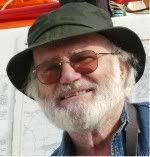The black-and-white photograph below, reproduced from a faded 60-year old press cutting, is of nostalgic interest to me in spite of its poor quality because it was the first of my photographs ever to appear in print. It was taken in 1947, shortly after I joined the staff of the Brighton and Hove Herald as a junior in the darkroom. Many thousands of publications later it still holds a place in my memory, not least for the fact that I got into trouble for borrowing the firm's Leica (the only camera at the time capable of taking hand-held night photographs) without permission!
I have often wondered if it was worth the trouble: newsprint was in short supply in the immediate post-war years and some of it was of exceptionally poor quality, and the picture did not look much better than this when newly published!
Trolleybuses were often referred to as 'whispering death'. They were very quiet and often could not be heard coming, which resulted in many accidents to pedestrians and cyclists who strayed into their path.
I have often wondered if it was worth the trouble: newsprint was in short supply in the immediate post-war years and some of it was of exceptionally poor quality, and the picture did not look much better than this when newly published!
Trolleybuses were often referred to as 'whispering death'. They were very quiet and often could not be heard coming, which resulted in many accidents to pedestrians and cyclists who strayed into their path.

A common problem with trolleybuses was that the collector arms had a habit of coming away from the wires and had to be manually replaced with a long hooked pole. It was also necessary to take them down when parked, so that other vehicles using the same wires could pass.
The photographs below show a maze of overhead wires at the East Anglian Transport Museum near Lowestoft, double for trolleybuses and single for trams, which used the rails as the second conductor.


 I grew up in the steam age, travelled to school and went on holiday by train. The sight, sound and smell of steam still revives nostalgic memories and I can never resist a visit to a restored railway.
I grew up in the steam age, travelled to school and went on holiday by train. The sight, sound and smell of steam still revives nostalgic memories and I can never resist a visit to a restored railway.
No comments:
Post a Comment